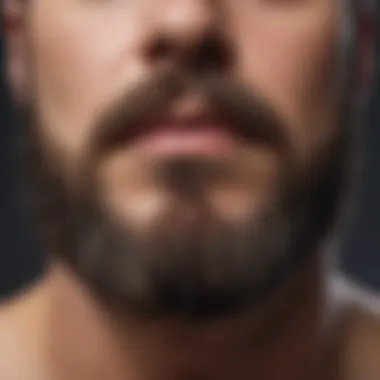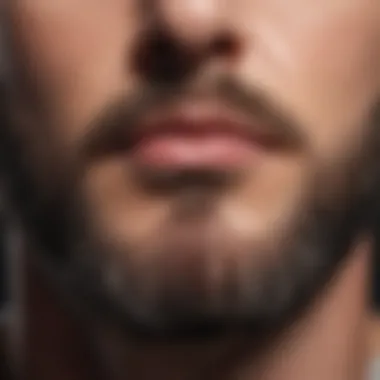Does Shaving Impact Beard Growth? Myths Explored


Intro
The notion that shaving impacts beard growth is deeply ingrained in popular culture. Many men have heard the adage that regular shaving may result in a thicker and faster-growing beard. But is there any truth to this belief? In this article, we will explore the interplay between shaving and beard growth, focusing on scientific findings and genetics.
Biological Basis of Hair Growth
Understanding hair growth requires a deep dive into biology. Each hair follicle goes through cycles of growth, rest, and shedding. Factors such as hormones and genetics largely govern these cycles. For instance, testosterone plays a prominent role in promoting facial hair growth in men. Genetic predisposition influences individual growth patterns.
When a person shaves, they cut the hair shaft. This removal of hair does not affect the follicle within the skin, where new hair originates. Therefore, evidence suggests that having a fresh shave does not stimulate thicker or faster regrowth.
Myth vs.
Fact
Many myths pervade the conversation on shaving and beard growth. These include:
- Myth 1: Shaving makes hair grow back thicker. Reality: Shaving results in blunt hair ends, giving an illusion of thicker hair, while the hair's actual composition and growth rate remain unchanged.
- Myth 2: Shaving promotes more frequent hair growth. Reality: Growth occurs based on genetic factors and hormones and not influenced by the act of shaving.
"A higher frequency in shaving doesn’t change how fast your hair grows; it simply alters appearance during that time."
Understanding Shaving and Grooming
Now that we understand the presumed link between shaving and beard growth is largely unfounded, let’s discuss grooming practices.
If a man desires a well-groomed appearance, adopting a proper shaving routine is essential. Using products like quality razors, aftershave, and moisturizers can prevent irritation and keep facial hair healthy.
Science of Hair Growth: Key Points
- Hair grows an average of half an inch per month.
- Baldness can occur genetically, independent of grooming habits.
- Environmental factors, diet, and overall health also contribute to hair quality.
When it comes to grooming and maintaining a beard, each man should analyze his personal growth patterns and adjust his approach to meet his grooming style.
Tips for Maintaining a Groomed Beard
- Invest in a good beard oil for moisture.
- Regularly trim the beard for evenness.
- Wash the beard with specialized shampoo to avoid buildup.
- Combing can help in distributing oils and prevents tangles.
Given the plethora of grooming options available, creating an optimal routine that suits hair needs is very beneficial.
Epilogue
While the belief that shaving influences beard growth might endure, it is essential to distill fact from fiction. Studies show limited power linking the act of shaving with increased growth rate or hair thickness. Personal genetics and testosterone levels remain the primary determinants of growth. Understanding mischievous myths surrounding shaving can inform more effective grooming processes, leading to notable style confidence.
As the beauty and grooming industry evolves, awareness of effective techniques commences, but knowledge should take precedence to inform daily grooming routines.
Preface to Beard Growth
Understanding the complexities of beard growth is essential in unpacking the widely held belief that shaving influences this process. While many maintain that regular shaving can promote thicker or faster growth, the evidence often does not support this idea conclusively. It is important for men who care about grooming and personal style to be informed about the biological and genetic factors that contribute to beard growth. Insight into this topic can lead to more effective grooming techniques and increased satisfaction with one’s look.
Understanding Hair Biology
Hair growth, including facial hair, is a physiological process rooted in biology. Each hair grows from a follicle that undergoes specific phases: anagen (growth), catagen (regression), and telogen (resting). The characteristics of hair can depend on various variables such as individual physiology, health, and heritage. Beard hairs have longer follicles and grow thicker in the anagen phase compared to scalp hair.
Thus, comprehending this biology is vital, as it directly ties into how shaving impacts or does not affect growth.


Factors Influencing Beard Growth
Beard growth is not solely reliant on lifestyle choices; several inherent factors play a significant role. They can be summarized as follows:
- Genetics: Genetic makeup primarily determines the density, texture, and overall growth pattern of one's beard. There’s a proven correlation between familial patterns and the absence or presence of facial hair. Men with fathers or brothers bearing robust beards are likely to experience similar growth.
- Hormonal Levels: The balance of hormones, particularly testosterone and dihydrotestosterone (DHT), influences beard growth. Higher concentrations can promote more vibrant and thicker facial hair. Hormonal imbalances, then, can potentially stunt growth or change hair characteristics.
- Age: Age impacts how and when men experience full beard growth. Younger men may notice thin patches or slower growth due to their still-evolving hormonal profiles. With age, hormonal levels often stabilize, improving growth potential.
Collaborative understanding of these factors enhances knowledge surrounding effective beard care practices while addressing the myths about shaving and beard growth.
The Shaving Myth
Understanding the idea that shaving can influence beard growth is essential for anyone interested in grooming and personal style. Many people hold the assumption that frequent shaving will somehow make their hair grow back thicker or faster. This myth persists, despite scientific evidence suggesting otherwise. Recognizing this issue impacts how we approach grooming techniques and perceive our hair growth journey.
Origins of the Belief
The belief that shaving somehow boosts hair growth has historical roots. This notion may originate from the physical changes hair goes through post-shaving. When someone shaves, they cut the hair at the thickest part, which can give the illusion of increased thickness as it regrows. Early societal practices and anecdotal experiences have further solidified this myth. As men have shared their collective grooming experiences, the myth kept gaining traction. People essentially wanted a quick fix for fuller-bearded looks without understanding the biological basis behind hair growth patterns.
Scientific Examination of Myths
Examination of the myth reveals not just its falsehood but also persistent misconceptions about how hair growth operates. Two key areas of interest include follicles and the nature of hair thickness itself.
Follicle Activity
Follicle activity refers to how hair follicles develop and enhance hair growth cycles. Each follicle is responsible for individual hairs and their growth rate can vary substantially among people. Importantly, shaving has no role in stimulating follicle activity. Once a hair is shaved, the follicle does not release hormones to encourage new growth; its natural cycle remains unchanged.
Key characteristics of follicle activity include its independence from external factors like shaving. This article emphasizes understanding this factor because it highlights a crucial aspect of how our body naturally processes hair growth. When one learns that shaving does not trigger any change at the follicle level, the myth weakens.
Hair Thickness Misconceptions
Given observations that hair may appear thicker upon regrowth, many confuse perception with reality. This misconception arises when comparing shaved hair to its longer and often more tapered counterparts. Therefore, individuals might feel hair appears coarser or denser after shaving, which supports the myth as they often posit causes which doesn't hold significant scientific weight.
This thought process around hair thickness misses essential information about the hair growth cycle and its anatomical features, favoring temporal visuals over substance. Understanding why thickness seems altered when regrowing hair becomes critical for debunking the myth. The more accurately one informs themselves about hair characteristics, the better they protect their grooming decisions from misguided beliefs.
Effects of Shaving on Growth
Understanding the effects of shaving on growth is crucial in debunking the myth that shaving somehow enhances beard development. Many people still believe that the more you shave, the quicker and thicker the hair will return. Evaluating both the immediate and lasting impacts of shaving practices can provide higher clarity.
Shaving Techniques and Their Impacts
Different Tools Used
When discussing different tools used for shaving, it’s imperative to highlight the variety available and their specific functions. The primary categories of tools include straight razors, safety razors, and electric trimmers. Each type offers a unique shaving experience and effectiveness in managing hair length.
Straight razors are noted for their clean shave capabilities and their appeal among traditionalists. This tool requires skill and practice, making it less appealing for beginners but rewarding for those experienced. On the other hand, safety razors promote ease of use, enabling most users to achieve satisfactory results without expending much effort. Electric trimmers offer convenience for quick touch-ups with minimal risk of cuts. Appropriate selection thus greatly influences the shaving experience, depending on individual preferences.
Each tool presents its calendared advantages and disadvantages in relation to the overall topic of hair growth. Depending on the tool, results can vary, whether for amateur or seasoned users prolonged use of a single type could influence maintenance routines and overall grooming discipline.
Skin Preparation
Preparing the skin diligently before shaving plays a pivotal role in the outcomes observed after grooming procedures. The essential practice includes cleansing the face, exfoliating dead skin cells, and employing moisturizing aids to soften the facial hair.
A proper cleanse leads to clear skin and healthier follicles, since trapped dirt can lead to ingrown hairs. An effective exfoliation process primes the way for a smooth blade passage, reducing the likelihood of irritation and skin reaction. Utilizing pre-shave oils adds a protective layer on the skin that allows for a smoother glide and less friction.
Besides the skin benefits, a well-prepped visage could minimize overall discomfort post-shaving. Even though the implications of skin preparation directly relate to aesthetics, failed preparation leads to complications and often diminishes the overall goal of grooming, which is to promote a neat appearance. Thus, investing time in skin preparation contributes significantly to achieving an appealing look.
Short-Term vs Long-Term Effects


Shaving can yield visible changes to beard growth patterns, but those impacts delineate between immediate results and an extended period. Understanding how each time-period reflects different facets of shaving will offer profound insight into grooming procedures. Short-term effects manifest as the immediate respond of skin and hair regrowth, while long-term effects usually incorporate changes related to habits and overall grooming choices.
“The belief that shaving influences hair thickness lacks substantive backing from dermatological perspectives.”
This informed viewpoint, paired with proper grooming techniques, plays critical crossroad in achieving desired beard texturer. Diving deeper into these aspects can yield the necessary truths men interested in styling often seek.
Expert Insights
Understanding expert insights is crucial in any discussion about grooming practices and their effects. In regard to shaving and beard growth, dermatologists and grooming professionals provide knowledge that brings clarity to common myths. These insights help separate fact from fiction, illuminating the biological factors at play and correcting misconceptions. By integrating their expertise, the article solidifies its basis with scientific understanding and professional advice, ultimately offering readers actionable information for their own grooming practices.
Dermatologists' Perspectives
Dermatologists often emphasize that hair growth occurs beneath the skin's surface, fundamentally independent of external practices like shaving. According to experts, the Follicles which house hair are responsible for growth, and these do not change in activity or performance based on shaving frequency.
Some key points from dermatologists include:
- Genetics Play a Role: The density and growth rate of facial hair are significantly dictated by one's genetic makeup. Those with a family history of thick beards are more likely to have similar results.
- Hormonal Balance: Hormones like testosterone influence beard growth. Shaving does not impact hormonal levels or their effects on hair follicles.
- Shaving_methodologies: Techniques and tools used for shaving may affect skin health, impacting how facial hair appears or feels after it grows back. Proper tools like razors designed for sensitive skin can play more of a role than actual shaving on productivity.
As dermatologists highlight, misinformation regarding shaving persists despite evidence contradicting it. Their recommendations focus on understanding individual biology and not adopting practices based on old beliefs.
Grooming Experts' Opinions
Grooming experts often provide insights that steer clear of common myths while generating curiosity about effective beard maintenance. Their discussions tend to focus on techniques and habits rather than the act of shaving itself. They stress that maintaining an established grooming routine is vital in promoting a healthy appearance of one's beard.
Considerations from grooming professionals often include:
- Trimming vs Shaving: Many experts advocate for trimming over shaving. Using scissors or specialized trimmers can keep facial hair neat without resorting to shaving. Trimming certain lengths can rejuvenate a beard's look while still promoting growth.
- Beard Care: Grooming experts recommend the use of high-quality products such as beard oils and conditioners that enhance the hair's natural sheen and softness. Proper skincare can lead to peak growth potential through retained moisture and nourishment, shaping appearance to mimic healthy flourishing.
- Personal Care: Encouraging regimens that also focus on overall aesthetics encompasses the knowledge that there are influences like beard density and potential patchiness. Grooming tips remain progress before embracing a more involved routine. They advocate for being versatile with one’s style and trying various products to find what optimally suits individual hair types.
In summary, insights from dermatologists and grooming experts highlight essential facts about beard growth. Understanding both biological factors and grooming practices ensures an advanced approach to beard management for those prominent interests in style trends.
Alternative Grooming Practices
The concept of grooming transcends mere appearance; it plays a crucial role in how individuals express themselves. This section examines the practices that go beyond shaving, highlighting their importance both for beard growth and overall hair health. The understanding of different grooming techniques allows people to cultivate a style that suits their preferences without relying solely on shaving.
Trimming vs.
Shaving
Trimming and shaving serve different purposes while also affecting beard appearance and health. Trimming maintains a well-groomed appearance without removing all facial hair, enabling a fuller beard grown over time. This action encourages a more even growth by removing split ends and preventing breakages. Unlike shaving, which can elevate the possibility of irritation or ingrown hairs, trimming offers a gentler touch to skin and hair. Time management is another aspect; trimming can often be performed hastily compared to the attentive process of shaving.
In contrast, shaving typically involves using razors, allowing for smooth skin presentation. However, this method does not stimulate hair growth; instead, it merely alters hair’s length and texture. By being mindful of the difference between these two grooming options, individuals can choose what aligns best with their lifestyle and grooming goals.
Beard Care Products
Beard Oils
Beard oils are essential in maintaining hair hydration and skin health. The primary characteristic of beard oils is a balanced blend of essential oils and carrier oils. This composition nurtures both the hair and the underlying skin, alleviating dryness or flakiness. These contributions render beard oils a popular choice among enthusiasts who want to promote healthy growth and a radiant beard appearance.
A unique feature of beard oils is their potency in softening coarse hair. Regular application encourages manageable, less tangled beards. Additionally, some oils may contain stimulating elements like jojoba or argan oil that enhances follicle health, potentially aiding in growth. Some users may experience an excess buildup if applied too liberally, which can result in greasiness and product wastage.
Conditioners
Conditioners serve as an additional boon in the broader category of beard care. The notable trait of conditioners is their conditioning agents which aim at penetrating hair strands, thus providing softness and managingability. This benefit is significant in reducing knotting that can appear in tangles often found in thicker growths. With a subtle scent, many conditioners can also enhance the overall odor of one’s facial hair, contributing to an appealing aesthetic.


However, one must balance usage; overconditioning might lead to greasy appearances and effects that counteract the natural sheen desired. When leveraged correctly, conditioners can help ensure that every strand appears lustrous while still being easy to style.
It’s not only about growth but also about maintaining the health and appearance of facial hair. The chosen care products contribute critically to this aspect.
In sum, an essential understanding of grooming methods like trimming alongside the application of specialized products, such as beard oil and conditioners, can encapsulate the significance of managing beard health effectively. Their advantages are more than cosmetic; they contribute materially to a man’s overall grooming ritual. Individuals who want to explore different techniques will find an avenue that resonates well with stylistic beliefs while also nurturing health. Overall health maximizes the grooming impact at a personal level.
Overall Health and Beard Growth
Overall health plays a significant role in influencing beard growth. One might think that techniques involving razor blades are the primary concern when it comes to cultivating facial hair. However, it is important to consider the underlying factors that impact our body’s hair growth capabilities. Effective circulation, well-being of hair follicles, and balanced hormones depend heavily on our health.
Factors such as nutrition and lifestyle directly relate to how efficiently beards can grow. Within the modern emphasis on grooming Regimens and hairstyling, men must appreciate the foundation that promotes the necessary hair proliferation. Sufficient nutrients provide the body with the building blocks essential for the hair structure. Moreover, executing a healthy lifestyle allows for optimal hormonal functions which are key to unlocking one’s potential beard growth.
To fully understand the intersection between health and facial hair, we look into systemic contributors:
- The correlation between one’s diet and hair vitality
- How enduring stressful episodes can hinder growth
- The effects of regular physical activity on overall vigor
Thus, it emerges that health is not merely an offshoot of good grooming. It is the central axis around which effective grooming and flourishng beard growth spin.
Nutrition's Role
Nutrition is foundational when it comes to the support of healthy hair growth. It directly influences hair follicles, often serving as the environment in which robust hair can develop. Important nutrients such as proteins, vitamins, and minerals are integral. Proteins offer essential amino acids fostering keratin production, a key structural component of hair.
Certain dietary components stand out:
- Vitamin A: This vitamin fuels the production of sebum, honing the scalp.
- Biotin: Often pinpointed for hair care, Biotin aids in keratin production as well and decreases hair loss.
- Zinc: It maintains and ensures the activities surrounding cell growth which impacts hair immensely.
It is crucial to consider food sources that facilitate these vitamins. Granola, nuts, rolled oats, fruits, eggs, and lean meats are vibrant examples rich in such resources. Thus, emphasizing proper nutrition not only nurtures overall health but significantly boosts the potential of beard growth and maintenance.
Lifestyle Factors
Lifestyle plays an equally striking role in determining beard growth rates. Good practices often yield profound results in how healthy hair may flourish.
Stress Management
Stress can severely limit one's capacity for productive hair growth, contributing to issues like hair loss or inhibition of follicle activity.
The accumulation of tension often leads to heightened cortisol levels, which is detrimental as it deters nutrient absorption and disrupts hormonal balance. Consequently, managing stress serves a critical measure in promoting beard growth. Among the popular techniques are mindfulness, meditation, and marginal breaks from daily stresses. Embrace quietude and nurturing recreational activities like yoga or gentle hobbies; these present advantageous alternatives that conclude to well-being and consequently often more luxuriant hair.
Exercise
Regular exercise serves two purposes: it enhances circulation and contributes to better emotional management. Cardio workouts such as jogging or swimming effectively elevate blood flow and transportation of vital nutrients to skin and hair follicles. This circulatory KPI is invaluable for maintaining healthy organ functionality and ensures nourishment extends upward into the facial hair area.
Unique benefits of a consistent exercise program include increasing hormone levels that promote hair growth. Substance like testosterone and endorphins usher an incredible feeling of vitality, contributing drastically to the environment for a flourishing beard. Introduce resistance training intermittently into one’s exercise plan to enhance muscular support, which translates further benefits within hair quality.
All things consider, overall health undeniably provides that bedrock framework necessary for optimal beard growth. Inquiry into factors spanning nourishment, psychological stability, and physical consistency encapsulates the collective design by which successful beard cultivation prevails.
Culmination
The exploration of whether shaving affects beard growth reveals complex dynamics associated with hair biology and grooming practices. Understanding beard growth is crucial for those serious about their appearance and overall grooming ethic. Recognizing myths versus truths allows men to make informed decisions on when and how to groom their facial hair, resulting in enhanced confidence and style.
Summary of Findings
Throughout this article, key findings include the understanding that shaving does not inherently influence hair growth. Hair growth is primarily driven by genetics and hormonal factors, not external factors such as frequent shaving. Below are main takeaways:
- Hair follicles do not respond to increased shaving frequency by becoming healthier or producing thicker hair.
- User experience varies; some report perception improvements after regular grooming, but this is more psychological than physiological.
- Understanding hair characteristics, such as density and texture, can direct grooming styles effectively.
Final Thoughts on Beard Growth and Grooming
To conclude, honing a personal grooming routine must balance accuracy with practicality. Choosing appropriate techniques and care products will lead to overall better beard health. Remember, it's less about how often you shave and more about how well you take care of your facial hair. Choose the method that represents your personal style, and don’t chase myths surrounding shaving.
Proper nutrition, supplemented by exercise and stress management, also contributes to overall health and can indirectly affect hair quality. Investing time in understanding these aspects will provide a more rewarding grooming experience, aligning it closely with individual style goals.















